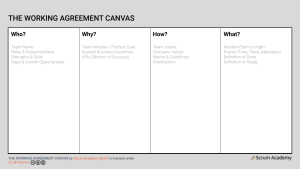How to create great working agreements using the Working Agreement Canvas

A few years ago, I came across this quote from Patrick Lencioni (Author of the book “The Five Dysfunctions of a Team”).
“Not finance. Not strategy. Not technology. It is teamwork that remains the ultimate competitive advantage, both because it is so powerful and so rare.”
It resonated with me as I had been part of some extremely successful and performant teams but also some teams that were truly dysfunctional. One of the key pillars of high performance in teams are shared rules of engagement or working agreements.
Independent of whether you are a Scrum team or any other type of team, the creation of working agreements help you build shared norms and move much quicker through the journey that almost every team goes through. The Working Agreement Canvas is a simple tool to help you facilitate the creation of working agreements and make sure you remember the most important pieces. So let’s dive into it together.
The Working Agreement Canvas
The Working Agreement Canvas consists of 4 building blocks:
- Who are we and what are our skills?
- Why do we work together, what do we want to accomplish?
- How do we intend to interact with each other and collaborate?
- What are we going to do concretely?
Our recommendation is to go through this canvas from left to right, but you can also start somewhere else.
Who?
This building block is about the people and the team. Who are we? What do we want to call our team? How do split roles & responsibilities? What are our skills? And where do we see gaps and growth opportunities?
All of these questions matter at the beginning of a project as they help us determine who is best suited for what and where we will see potential skill-based bottlenecks. As with all following building blocks the “Who?” is a living document. Over time, our team composition might change, our skills will change and we might need to update the Working Agreement Canvas.
Why?
Why are we working together? What is the Mission or Product Goal we want to achieve? What business outcomes are we working towards and how will we track our progress and success?
This building block can be filled much easier if a team has created the Product Goal first. You can also start with this building and later deep-dive in the Product Goal Canvas. Whatever order you pick, make sure you have not only alignment within the team on this piece of your working agreements, but also with your key stakeholders.
How?
This is all about our values, both as a team and as an organization. It’s important to be on the same page of whether we value e.g. a high pace with quick decentralized decisions or whether we are OK with being slower while investing the time to get everyone’s input and seek consensus.
Do not spend too much time here and get into philosophical questions. Also, remember that values are the things we do… how we show up to work. Anything we put into this building block needs to have a meaning for us in our daily job.
What?
This building block is about all the concrete things e.g. what is our iteration length, on which day do we do Sprint Planning, who takes care of inviting people. Also, create alignment and transparency around such topics as the Definition of Done and the Definition of Ready if you choose to have them – we recommend you do.
One more thing about the Working Agreement Canvas
Or actually two 😉 If multiple teams are working on the same product consider to create a shared working agreements. It is important to be aligned as a larger group. Also, remember to revisit your working agreements from time to time. This does not mean you do that every sprint (depends on your sprint length though), but whenever you realize that something is off, it is probably a good idea to look at your working agreements and check whether your team is still committed to them and/or whether they need to be updated.
With that being said, enjoy using the Working Agreement Canvas. We hope it will play a small role in building better teams to make society more productive, more humane, and more sustainable.
You can download the Working Agreement Canvas. If you want to learn more about how to use the Working Agreement Canvas and other concepts to build great teams, join our Certified Scrum Master Trainings.
Leading an Agile Transformation
=> What you should know when starting an Agile Transformation
The Definition of Done
=> This is how you find your own Definition of Done (DoD) for your team
Servant Leadership
=> How does Servant Leadership work for a Scrum Master?
